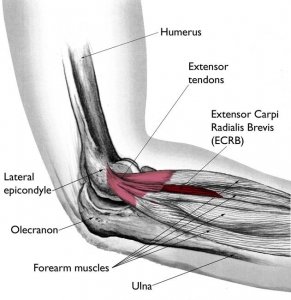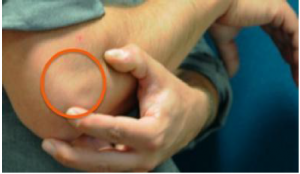Tenis Elbow/Lateral Epicondylitis
What is lateral epicondylitis?
Lateral epicondylitis is an age-related pain phenomenon at the lateral side of the elbow. The wrist extensor muscle (Extensor Carpi Radialis Brevis/ECRB) inserts on the lateral epicondyle of the elbow. The ECRB muscle stabilizes the wrist in extension and more importantly for power grip.
It is thought that degeneration or tearing of the tendon attachment to the elbow bone is the cause of symptoms. The exact mechanism and reason for symptoms, however, is unknown.
Who gets lateral epicondylitis?
“I don’t play tennis, why do I have tennis elbow?” is one of the most common questions regarding lateral epicondylitis. It is most common in those between 35-65 years old, regardless
of activity level. Sometimes a patient can report a sudden increase in pain, or it can be a more insidious onset. It is thought to be an overuse injury, but the actual cause is not understood.
What are the symptoms of lateral epicondylitis?
Pain with pressure on the bony prominence of the elbow is very common. Lateral elbow pain with power grip and pain with wrist extension are hallmarks of lateral epicondylitis. Also pain with passive wrist flexion is common.
How lateral epicondylitis treated?
Google tennis elbow or lateral epicondylitis and one will find a thousand different treatments. This tells us it is a common condition and that perhaps we don’t know how best to treat it.
There are hundreds of papers studying different treatment modalities for lateral epicondylitis. Interestingly, almost all treatment results are equal to placebo (doing nothing). This includes bracing, injections of blood, platelets, bone marrow, shock wave, ultrasound-guided methods, etc. We do know that steroid injections into the elbow are worse than doing nothing (JAMA 2013). Interestingly, anti-inflammatory medications and treatment don’t work as it is not an inflammatory condition.
In fact, nothing works better than doing nothing!
Obviously, our goal with patients is to get them to pain-free function. I believe that exercises are the way to go early on for lateral epicondylitis. In theory, by exercising the specific muscles affected, the parts of the muscle still attached to the elbow will strengthen. This will allow the “torn” and “degenerative” areas to heal. I have great success early on treating lateral epicondylitis with an exercise program. Often, I will use a few supervised therapy visits to ensure that the patient is doing the exercises appropriately.
I don’t believe that one should stop activities because of lateral epicondylitis to allow it to heal. Exercising it before the activity to warm up the muscle will allow the patient to compete in whatever exercise or sport they want. It is, after all, a pain phenomenon.
Surgical treatment is reserved for longstanding symptoms (>6-9 months). Surgery is almost always effective. The muscle that is degenerative is removed and the remaining tendon is sewn down to the bone.



